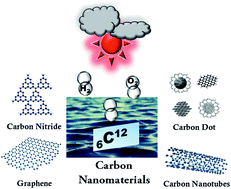Carbon-based nanomaterials: in the quest of alternative metal-free photocatalysts for solar water splitting
Abstract
One of the alarming problems of modern civilization is global warming due to the inevitable rise of CO2 in the environment, mainly because of the excessive use of traditional fossil fuels. The gradual depletion of fossil fuels is another challenge regarding the future energy demand; therefore, alternative renewable energy research is necessary. One of the alternative approaches is the solar fuel generation by means of photocatalytic water splitting and more specifically, hydrogen evolution from water through the reductive half-reaction. Hydrogen is the cleanest fuel and does not produce any greenhouse gas upon direct combustion, or even while acting as a chemical feedstock for other transportable fuel generation. Therefore, it is desirable to produce efficient photocatalysts for solar water splitting. After the discovery of the first photocatalytic water splitting reaction by Fujisima and Honda, several advancements have been made with metal-based inorganic semiconductor photo-catalysts. However, their practical applicability is still under debate considering the environmental sustainability, stability and economical expenses. As a result, it is essential to develop alternate photocatalysts that are environmentally sustainable, cost-effective, stable and highly efficient. The metal-free approach is one of the most promising approaches in this regard. Herein, we discuss the recent developments in carbon-based materials and their hybrids as alternative metal free photocatalysts for solar water splitting. The present discussion includes g-C3N4, two-dimensional graphene/graphene oxides, one-dimensional carbon nanotubes/carbon nanofibers and zero-dimensional graphene QDs/carbon dots. We have focused on the rectification of exciton generation, charge separation and interfacial photochemical processes for photocatalysis, followed by possible optimization pathways of these typical all carbon-based materials. Finally, we have highlighted several fundamental challenges and their possible solutions, as well as the future direction on this particular aspect.

- This article is part of the themed collection: Recent Review Articles


 Please wait while we load your content...
Please wait while we load your content...